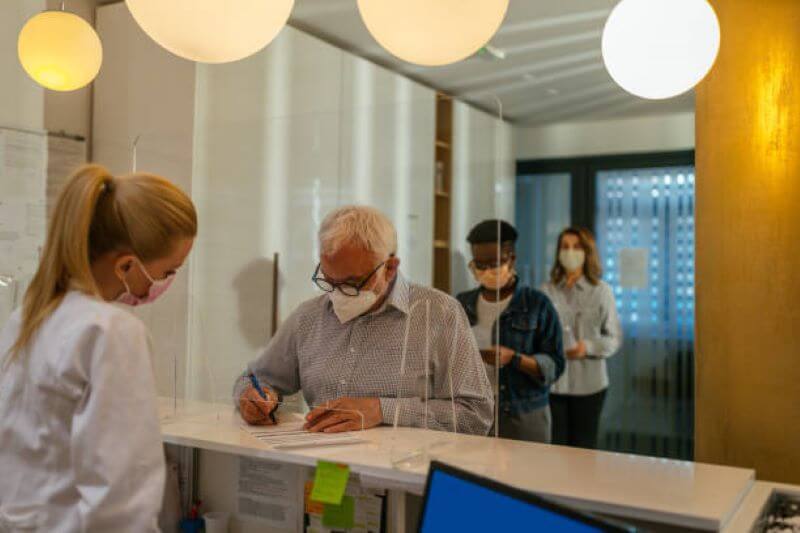Suppose you’ve ever been treated at the hospital or been deeply involved in the medical situations of someone close to you. In that case, you’re probably aware of how vital patient experience is.
Having to wait in the waiting area for too long, not having a nurse or doctor around to cater to you promptly, or a lack of cleanliness may be why patients tend to get frustrated upon visiting hospitals and clinics.
It is essential to understand that these frustrations impact patients’ perception of hospitals, which in turn affects their health outcomes as well as the customer retention and revenue generation of hospitals.
It is, therefore, essential to prioritize patient experience when planning the operations of medical services.
Follow along in this blog and let us help you understand just how crucial the role of patient experience can be and what some of the most effective solutions for improving patient experience are.
What is Patient Experience?

Patient Experience (PX) in healthcare is pivotal in influencing industry success. It encompasses perceptions at every touch point, from digital services like online consultations to physical visits.
A positive PX correlates with high-quality care, offering efficiency, comfort, and faster recovery. This not only improves health outcomes but also boosts hospital revenue.
Moreover, PX extends beyond medical interactions, encompassing administrative processes like appointment booking and bill payments. In today’s competitive healthcare landscape, prioritizing PX is a strategic imperative for hospitals and clinics, ensuring financial success and a reputation for excellence in patient care.
Patient Experience VS Patient Satisfaction
Patient experience and patient satisfaction are terms often thought of as synonymous and are used interchangeably.
However, they are both different regarding what they mean, how they function, why they have impacts, and how they can be worked upon.
If you are someone looking to improve the PX in your clinic or hospital, it is crucial that you first understand the difference between the two so that you are clear on what you should be working on.
As described above, patient experience refers to patients’ overall perception of a medical service facility after interacting with it through both digital and physical platforms.
PX is specific to patients’ actual, real-life interactions with services provided by clinics and hospitals. Therefore, to gauge the quality of the patient’s experience, talking to them and asking them about everything that happened during their journey is necessary.
On the other hand, patient satisfaction in healthcare has to do with the expectations that patients have from the medical services they are being provided. They are satisfied if their expectations are met; if not, they leave disappointed.
What is important to consider here is that patient satisfaction can vary from person to person depending on the nature of their expectation and is, therefore, very subjective. It cannot help pinpoint specific issues within a patient’s journey because they vary for everyone.
Statistics on Patient Experience
With the world becoming increasingly fast-paced, consumer expectations continuously rising, and growing awareness regarding the quality of healthcare services – especially since the COVID-19 pandemic – patient experience has become a crucial factor in determining the success of hospitals and the rate of favorable health outcomes.
In fact, according to Matthew Gitelis, CEO of PatientIQ, patient experience is expected to be the top priority in the medical field in 2023, with a specific focus on introducing digital solutions to address existing pain points.
As developed in the passages above, patient experience is critical not only in ensuring that hospitals run smoothly, expand business, and earn higher revenue but also in improving health outcomes.
Research has been carried out over many years to determine the relationship between patient experience and health outcomes. According to most of these studies, the two are positively related, meaning that when patients have a good experience interacting with the medical services in hospitals/clinics, their health fares better.
According to one study in 2010, 13 out of 14 measures of success for treating heart attacks could be attributed to positive patient experience.
This shows that patient experience also has an impact on chronic illnesses. In fact, according to another study published in the Journal of General Internal Medicine, a smooth experience in the medical journey of diabetic patients results in better control of their blood sugar.
Examples of Patient Experience
Patient experience can be good if it leaves patients happy with their interactions during their medical journey and wrong if they have pain points that cause frustration and leave them with a negative perception of the healthcare service in question.
Here are some patient experience examples to help you understand which aspects of a medical service customers appreciate and which ones they find challenging to deal with.
Good patient experiences include the ability to book appointments on time, having easy access to healthcare-related information, and having staff members available to solve issues and answer queries on time.
Furthermore, a well-developed PX means strong communication between patients, their doctors, and nursing staff, a strict standard of food and hygiene is maintained, and patients are given personalized services.
Bad patient experiences, on the other hand, include having to wait for hours in the waiting area before the hospital space is made available to them for treatment, the rude attitude of the doctors and nursing staff, lengthy payment procedures for medical bills, and a lack of good food and proper hygiene.
Patients also find it frustrating when they are not provided with individual care and their concerns are not dealt with in time due to the staff members’ lack of interest or availability.
Personalized patient experience is highly essential and plays a vital role in helping hospitals/clinics run more smoothly and in curing patients. This is because when the doctors and nursing staff give patients individual attention, they feel they are essential and are being well taken care of.
They become more willing to take their medicines on time and follow the precautionary measures given to them. This, in turn, results in positive health outcomes.
When these patients get cured, they spend less time in the hospital, reducing the pressure on doctors and nurses and the costs of treating them. This and the spread of optimistic reviews about their time at the hospital contribute to efficient operations and increased healthcare providers’ revenue.
Why Is Patient Experience Important?
Patient Experience (PX) holds significant importance in the healthcare industry for several compelling reasons:
- Enhancing Patient Care Experience: Improving patient experience leads to higher-quality care, ensuring patients receive the attention and support they need for better health outcomes.
- Building Trust and Rapport: Positive PX cultivates trust between healthcare providers and patients, fostering open communication and a collaborative approach to care.
- Increasing Patient Satisfaction: A positive PX leads to higher patient satisfaction rates, resulting in more excellent patient retention and positive referrals, ultimately enhancing the healthcare facility’s reputation.
- Boosting Operational Efficiency: Patient-centered processes lead to streamlined operations, reducing wait times and administrative hiccups creating a more efficient healthcare environment.
- Facilitating Faster Recovery: A comfortable and supportive environment contributes to a patient’s overall well-being, potentially leading to a speedier recovery process.
- Elevating Financial Performance: Improving patient experience can increase patient loyalty and retention, increasing healthcare providers’ revenue.
- Promoting Patient Education: A positive PX encourages patients to be more engaged in their treatment plans, leading to better understanding and compliance with medical advice.
- Enhancing Staff Morale and Satisfaction: Focusing on patient experience creates a more positive work environment for healthcare professionals, improving job satisfaction and care delivery.
Prioritizing patient experience is integral to patient-centered care and reaps numerous benefits for patients and healthcare providers.
Importance of CAHPS Surveys to Measure Patient Experience
Gathering patient feedback is one the most effective ways healthcare providers can identify common pain points in the patient’s journey and take appropriate measures to address these shortcomings to improve their patient experience.
Consumer Assessment of Healthcare Providers and System (CAHPS) surveys are an excellent way of gaining this feedback.
CAHPS surveys are designed using a particular set of protocols that ask patients specific questions about their experience and enable the data gathered to be compared across multiple healthcare settings.
Moreover, these surveys are conducted on a large sample of patients and are subject to strict scrutiny under a panel of experts. They are also available for public comment. This helps to ensure that the information collected is unbiased and an accurate measure of the existing PX.
Patient Experience – FAQs
What Are Examples of Patient Experience?
Patient experience includes clear, compassionate communication, a comfortable environment, and timely access to appointments and results.
What Are The 5 Key Initiatives of The Patient Experience?
Prioritizing staff training in empathy, personalizing care plans, seeking and acting on feedback, implementing clear communication channels, and enhancing waiting area comfort are 5 key initiatives of the patient experience.
What Are The 4 Pillars of Patient Experience?
Quality care, effective communication, accessibility, and a comfortable environment are the foundational pillars of a positive patient experience.
What Is the Most Important Aspect of The Patient Experience?
Effective communication stands as the cornerstone of patient experience. It fosters trust, enables shared decision-making, and ensures patients feel heard and valued in their healthcare journey.
Conclusion
Patient experience is crucial in determining the quality of healthcare services being provided to people. Good PX means that when patients interact with these services, they leave with a positive overall perception of the medical facility where they are being treated.
A well-developed patient experience means that patients are catered to promptly, dealt with a caring attitude from the doctors and nursing staff, and treated in an environment that prioritizes cleanliness and healthy food.
On the other hand, common pain points for patients include difficult access to information, rude attitude of the staff members, and poor hygiene standards.
Maintaining a good patient experience is essential because it results in better health outcomes by enabling patients to be treated in a comfortable environment and recover faster.
The patients’ positive experience also plays a huge role in stabilizing the conditions of people with chronic illnesses like diabetes. In addition to this, patient experience is also necessary to build patient loyalty, increase employee satisfaction, reduce costs, and increase revenue.
With increased digitization and higher patient expectations, healthcare services are moving towards digital solutions to develop their PX.
Some of these solutions include digital signage and self-service kiosks. Wavetec has provided several healthcare facilities with practical solutions to improve patient experience, such as queuing solutions in the Primary and Secondary Healthcare Department in Punjab, Pakistan.
Patient feedback can be beneficial in helping healthcare providers determine the pain points their patients have so that they can take relevant measures to improve their patient experience. CAHPS surveys are one way in which this feedback can be gathered.



